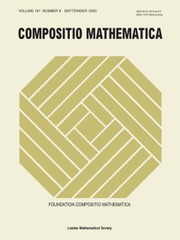Article contents
 $A_{\infty }$-algebras associated with curves and rational functions on
$A_{\infty }$-algebras associated with curves and rational functions on  $\mathcal{M}_{g,g}$. I
$\mathcal{M}_{g,g}$. I
Published online by Cambridge University Press: 10 March 2014
Abstract
We consider the natural  $A_{\infty }$-structure on the
$A_{\infty }$-structure on the  $\mathrm{Ext}$-algebra
$\mathrm{Ext}$-algebra  $\mathrm{Ext}^*(G,G)$ associated with the coherent sheaf
$\mathrm{Ext}^*(G,G)$ associated with the coherent sheaf  $G=\mathcal{O}_C\oplus \mathcal{O}_{p_1}\oplus \cdots \oplus \mathcal{O}_{p_n}$ on a smooth projective curve
$G=\mathcal{O}_C\oplus \mathcal{O}_{p_1}\oplus \cdots \oplus \mathcal{O}_{p_n}$ on a smooth projective curve  $C$, where
$C$, where  $p_1,\ldots,p_n\in C$ are distinct points. We study the homotopy class of the product
$p_1,\ldots,p_n\in C$ are distinct points. We study the homotopy class of the product  $m_3$. Assuming that
$m_3$. Assuming that  $h^0(p_1+\cdots +p_n)=1$, we prove that
$h^0(p_1+\cdots +p_n)=1$, we prove that  $m_3$ is homotopic to zero if and only if
$m_3$ is homotopic to zero if and only if  $C$ is hyperelliptic and the points
$C$ is hyperelliptic and the points  $p_i$ are Weierstrass points. In the latter case we show that
$p_i$ are Weierstrass points. In the latter case we show that  $m_4$ is not homotopic to zero, provided the genus of
$m_4$ is not homotopic to zero, provided the genus of  $C$ is greater than
$C$ is greater than  $1$. In the case
$1$. In the case  $n=g$ we prove that the
$n=g$ we prove that the  $A_{\infty }$-structure is determined uniquely (up to homotopy) by the products
$A_{\infty }$-structure is determined uniquely (up to homotopy) by the products  $m_i$ with
$m_i$ with  $i\le 6$. Also, in this case we study the rational map
$i\le 6$. Also, in this case we study the rational map  $\mathcal{M}_{g,g}\to \mathbb{A}^{g^2-2g}$ associated with the homotopy class of
$\mathcal{M}_{g,g}\to \mathbb{A}^{g^2-2g}$ associated with the homotopy class of  $m_3$. We prove that for
$m_3$. We prove that for  $g\ge 6$ it is birational onto its image, while for
$g\ge 6$ it is birational onto its image, while for  $g\le 5$ it is dominant. We also give an interpretation of this map in terms of tangents to
$g\le 5$ it is dominant. We also give an interpretation of this map in terms of tangents to  $C$ in the canonical embedding and in the projective embedding given by the linear series
$C$ in the canonical embedding and in the projective embedding given by the linear series  $|2(p_1+\cdots +p_g)|$.
$|2(p_1+\cdots +p_g)|$.
Information
- Type
- Research Article
- Information
- Copyright
- © The Author(s) 2014
References
- 6
- Cited by

